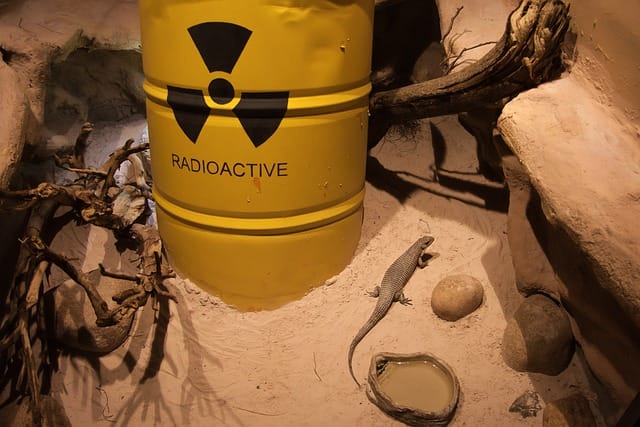Radioactivity and radioactive decay are central concepts in nuclear science, with profound implications in various fields such as energy production, medicine, and environmental protection. These phenomena are not just academic—they affect our everyday lives in areas ranging from the electricity that powers our homes to the technology used to diagnose and treat diseases. Understanding radioactivity and radioactive decay can unlock new opportunities for advancements in nuclear technology, radiation safety, and more.
What Is Radioactivity?
Radioactivity refers to the process by which unstable atomic nuclei release energy in the form of radiation. This radiation can consist of particles (such as alpha or beta particles) or electromagnetic waves (like gamma rays). The unstable nuclei that undergo these transformations are often referred to as radioisotopes, and the process of radioactive decay is what leads to the emission of this energy.
The discovery of radioactivity in the late 19th century by Henri Becquerel and subsequent studies by scientists such as Marie and Pierre Curie revolutionized our understanding of atomic structure. Today, the principles of radioactivity and radioactive decay are essential to many industries and scientific disciplines.
How Radioactive Decay Works
At the heart of radioactivity is the process known as radioactive decay. This is the natural mechanism by which an unstable atomic nucleus loses energy by emitting radiation. Over time, these unstable nuclei transform into more stable ones, and this transformation is often characterized by a property called the “half-life.” The half-life is the time required for half of a radioactive substance to decay, and it varies dramatically between different isotopes—from fractions of a second to millions of years.
Types of Radioactive Decay
There are three main types of radioactive decay: alpha decay, beta decay, and gamma decay. Each type involves a different kind of emission and results in a transformation of the atomic nucleus.
Alpha Decay: In this process, the nucleus emits an alpha particle, which is made up of two protons and two neutrons. Alpha decay typically occurs in heavy elements such as uranium and radium. The loss of an alpha particle decreases the atomic number of the element by two, resulting in the formation of a new element.
Beta Decay: In beta decay, a neutron in the nucleus is transformed into a proton, and an electron (or positron) is emitted. The electron is known as a beta particle. This process increases the atomic number of the element by one, again leading to the formation of a new element. Beta decay is significant in medical applications, such as in nuclear medicine, where it is used for diagnostic and therapeutic purposes.
Gamma Decay: After alpha or beta decay, the nucleus may still have excess energy, which it releases in the form of gamma radiation—high-energy electromagnetic waves. Gamma rays do not alter the atomic number or mass of the element but reduce the energy of the nucleus.
Applications of Radioactivity and Radioactive Decay
The discovery of radioactivity and the understanding of radioactive decay have had a wide range of applications in modern science and technology. Let’s explore some key fields where these processes are critical.
1. Nuclear Energy Production
One of the most significant applications of radioactive decay is in nuclear energy. In nuclear reactors, the process of nuclear fission—where atomic nuclei split apart—produces vast amounts of energy. This fission process involves radioactive materials such as uranium-235, which undergoes decay and releases energy as heat. This heat is then used to produce steam, which drives turbines to generate electricity.
Nuclear energy provides a significant portion of the world’s electricity. It is seen as a cleaner alternative to fossil fuels, as it does not emit greenhouse gases during operation. However, the safe management of radioactive materials and nuclear waste is a critical concern, which is why understanding radioactive decay is so important for ensuring the long-term sustainability of nuclear energy.
2. Nuclear Medicine
In the field of medicine, radioactivity and radioactive decay play crucial roles in both diagnosis and treatment. Nuclear medicine involves the use of radioisotopes, which are atoms with unstable nuclei, for imaging and therapeutic purposes. One of the most commonly used isotopes in nuclear medicine is technetium-99m, which emits gamma radiation and is used in diagnostic imaging.
Radioactive decay is also employed in radiotherapy, where high-energy radiation is used to target and destroy cancer cells. For example, Lutathera radiation safety protocols are used when treating patients with specific types of cancer, using lutetium-177, a radioisotope that decays by emitting beta particles. This type of therapy allows doctors to precisely target cancerous tissues while minimizing damage to surrounding healthy cells.
3. Environmental Radiation Protection
The natural and man-made sources of radioactivity in the environment necessitate rigorous environmental radiation protection measures. Understanding radioactive decay helps in the monitoring and regulation of radiation levels in the environment, particularly around nuclear power plants and other facilities that handle radioactive materials.
In areas exposed to radiation, institutions like the Radiation Protection Institute develop guidelines to ensure that exposure levels are kept within safe limits. This is especially important in cases where radioactive materials could leak into soil or water, posing long-term health risks to the population.
Radioactive Decay and Human Health
While radioactivity is harnessed for beneficial purposes, it also poses health risks if not properly managed. Prolonged or high-level exposure to radiation can cause damage to living tissue, leading to conditions such as radiation sickness, cancer, and genetic mutations. Therefore, understanding radioactivity and radioactive decay is critical for designing safety measures to protect both workers and the public from these risks.
Radiation Safety in Healthcare
In healthcare, patient safety is paramount when using radioactive materials for diagnosis or treatment. Patient radiation safety protocols are designed to minimize the exposure of patients to harmful levels of radiation while ensuring that the benefits of the treatment are maximized.
For example, radiation is used during fluoroscopy, a type of medical imaging that allows real-time viewing of internal structures. Radiation protection during fluoroscopy involves wearing protective gear and using lead shields to reduce exposure to both patients and healthcare professionals.
Radiation Safety During Pregnancy
Special precautions must be taken to protect pregnant women from radiation exposure, as it can cause developmental issues in the fetus. Radiation safety during pregnancy is a critical consideration in medical settings, especially when pregnant women are undergoing diagnostic tests that involve radioactive substances.
Managing Radioactive Materials Safely
Handling and disposing of safe radioactive materials is a major challenge in industries such as nuclear energy and healthcare. Radioactive materials must be carefully controlled to prevent environmental contamination and minimize the risk to human health.
Safe Storage and Disposal
In nuclear power plants, the safe storage and disposal of nuclear waste are of primary concern. Spent nuclear fuel, which contains radioactive isotopes, remains hazardous for thousands of years. Advanced techniques are being developed to contain and store this waste securely, preventing it from leaching into the environment. Understanding the long-term effects of radioactive decay is crucial in this process.
Radioactivity and Radioactive Decay in Nuclear Physics
The study of nuclear physics is deeply intertwined with radioactivity and radioactive decay. This branch of physics seeks to understand the forces and particles within atomic nuclei and how they interact. Courses such as nuclear physics by Roy and Nigam or nuclear reactor physics by Stacey provide detailed insights into the theoretical and practical aspects of nuclear science.
Quantum Mechanics and Nuclear Decay
At the core of nuclear physics is quantum mechanics, which explains how particles like protons and neutrons behave within the nucleus. The unpredictable nature of radioactive decay is a direct consequence of quantum mechanics. While we can predict the probability of decay over time (through the concept of half-lives), the exact moment when an individual atom will decay remains random. Quantum mechanics and nuclear physics intersect in this fascinating realm of unpredictability, offering insights into the very fabric of matter.
The Future of Radioactivity and Radioactive Decay Research
Research into radioactivity and radioactive decay is ongoing, with exciting new developments on the horizon. Whether it’s improving the safety and efficiency of nuclear power plants, developing new radioisotopes for medical treatments, or enhancing our understanding of atomic structures, the future holds immense promise.
Advancements in Nuclear Energy
One area of active research is in reducing the amount of waste produced by nuclear reactors. By improving our understanding of chemistry of nuclear power, scientists hope to develop reactors that use fuel more efficiently and produce less radioactive waste. Nuclear chemistry experiments are central to this effort, offering potential breakthroughs in energy production.
Innovations in Nuclear Medicine
In the medical field, new radioisotopes are being developed to improve the precision of diagnostic imaging and the effectiveness of cancer treatments. For example, nuclear chemistry crash courses often highlight how radioisotopes like fluorine-18, used in PET scans, are helping doctors diagnose conditions with greater accuracy.
Conclusion
Radioactivity and radioactive decay are not only fundamental scientific processes but also powerful tools that have transformed industries as diverse as energy, healthcare, and environmental protection. From the electricity generated by nuclear reactors to the life-saving treatments provided in nuclear medicine, the understanding and control of radioactive decay will continue to shape the future of science and technology. As research progresses, we can expect to see even more innovations that leverage the potential of these natural phenomena while ensuring the safety and well-being of the global population.






